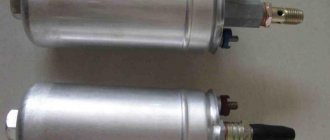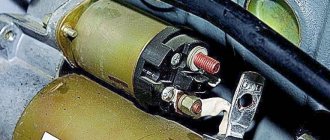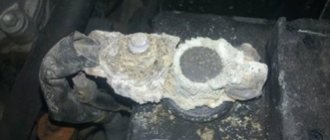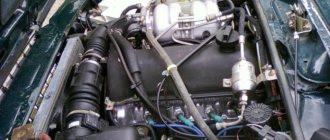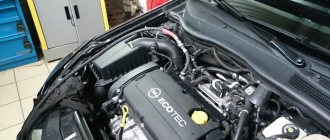Now many Russians cannot imagine life without a car. Therefore, it is easy to understand them when the vehicle suddenly stops starting at one, far from perfect moment. This is even more unpleasant if it happens in the morning before leaving for work.
At the same time, many car enthusiasts are lost in such a situation and have absolutely no idea how to fix the breakdown on their own.
This material will tell you why a car like Priora may not start in cold weather, and why its starter does not turn. It is important to note that in most cases the problem can be easily fixed on the spot, and if you know how to do this, you can save a lot of money on a car service.
What to do if the Lada Priora does not start and the starter does not turn
Now many Russians cannot imagine life without a car.
Therefore, it is easy to understand them when the vehicle suddenly stops starting at one, far from perfect moment. This is even more unpleasant if it happens in the morning before leaving for work. At the same time, many car enthusiasts are lost in such a situation and have absolutely no idea how to fix the breakdown on their own. This material will tell you why a car like Priora may not start in cold weather, and why its starter does not turn. It is important to note that in most cases the problem can be easily fixed on the spot, and if you know how to do this, you can save a lot of money on a car service.
Reasons for failure of the starting system
Most often the following happens:
- For some reason the electric starter does not turn on - the reason is a broken wiring, short circuit or breakdown of the traction relay;
- the starter starts, but an uncharacteristic clicking sound is heard - damage to the coil of the above relay or discharge of the battery;
- the start works, but the starter does not turn or rotates too slowly - the battery is dead.
In addition, the reason here may lie in:
- loss of contact;
- brush wear;
- collector contamination;
- short circuit of the winding wires.
It also happens that the starter works normally, but the flywheel still does not rotate.
Here, first of all, you need to make sure that the attachment to the crater installed on the clutch is not broken. Then you will have to check the integrity of the teeth of the flywheel itself or the drive gear.
It happens that the 16-valve Priora does not turn off the starter after the power plant is factory installed. This happens due to a malfunction of the clutch that ensures the free movement of the unit in question. Sticking of the relay contact group also leads to the same result. If this malfunction occurs, you must immediately turn off the engine.
Problems with the Priora plant often arise due to ignition failure. In this case, you need to make sure that:
- the coils are securely fastened to the power plant;
- there was no break in the ignition wires in its low-voltage circuit;
- whether the spark plugs are working (if there is no spark, you will need to replace the ignition coil).
And finally, it is impossible to start the engine if there is a breakdown in the power system. You will need to check the air filter. If it is not clogged, you need to inspect the connector contacts in the injection system (do not forget to also look at the fuel pump - if it does not make noise, then most likely there are problems with the electrical network) and make sure that the fuel pressure is normal.
Before performing the steps mentioned above, be sure to disconnect the negative connector on the battery. This should only be done with the ignition off.
Problems with the relay or battery
If, when you try to start a Priora car or a car of another brand, you hear a click, but the starter turns very slowly, you need to clean the nickels.
In some situations it may be necessary to solder a new contact layer. If you suspect that the cause is in the motor, you need to close the contacts in the relay. If after this the engine was able to start the first time, look for the cause of the malfunction in the relay. Otherwise, the cause lies in the engine itself. Often this problem occurs due to a fault in the relay. This is evidenced by the occurrence of several clicks that occur one after another when trying to start the car. If you listen, it becomes clear that this sound is made by a relay. It occurs due to the fact that the starter receives an electrical charge, but the current only reaches the traction relay and does not reach the engine spin-up mechanism. In this case, you can immediately rule out the version of a discharged battery, since due to the low charge, the starter would still be able to turn, but slowly and only a few times.
Source
Starter operating principle
This device itself is a conventional electric motor. A gear is installed on it, which meshes with the flywheel, which rotates when the power unit starts. A traction relay is also attached to the housing. The functions of this element include:
- gear movement control;
- starter disconnection.
When the key is turned to the starting position, voltage is supplied to the relay, exciting the electromagnet windings, then the contacts close. At the same time, the gear begins to rotate and the motor starts.
When the key is released, the voltage to the relay windings stops supplying and the contacts separate. The starter is accordingly turned off. This is, in general, the entire description of the operation of the node in question.
Mechanical and electrical problems
The engine starter may not work due to wear out of the bearings located at the front and rear of the engine. Their function is to ensure smooth acceleration of the starter shaft. If they are worn out, the retractor will make clicks, and the crankshaft of the power unit will remain motionless. The reasons for this problem are:
- imbalance of the starter shaft;
- burning or short circuit of winding turns.
Note that this may cause a short circuit in the vehicle's electrical circuit, which may cause a fire. If the starter does not respond to turning the ignition key, you cannot force it to work for a long time. It is best to make several short starts of the engine.
Since the design of the vehicle’s power unit starting device is based on an electric motor, the voltage necessary to increase the speed of its shaft is supplied to the winding through graphite brushes. The material they are made of does not have sufficient strength, these elements wear out quickly.
Why may the starter not turn?
If the start occurs in a cold or frosty environment, then several attempts should be made before starting to troubleshoot. In case of a complete fiasco, when when you turn on the relay clicks and the indication on the panel goes out, you need to do the following:
- make sure the battery is charged;
- check whether all the wires coming from the battery are cold - the presence of heating indicates poor contact (the terminals need to be cleaned);
- see whether the battery connectors are securely connected to the ground, and whether it is securely connected to the body of the car (existent contaminants are eliminated);
- make sure that the plus on the starter contact is holding well.
The traction relay is disconnected from the wiring if there is doubt about the normal operation of the ignition switch. Then the key is set to start, and a multimeter is used to check the presence of voltage directly at the removed connector.
When none of the above helps, you will need to dismantle the starter itself.
Individual situations
If the VAZ 21099 injector stops starting, you can try to close the contacts of the mechanism in a straight line.
We recommend: Oil leakage from under the crankshaft oil seal: causes and troubleshooting
But sometimes there are emergency situations when the device stops functioning, let’s consider a few of them:
- The injection engine does not start in cold weather, but all devices work normally, the battery is charged. If there is no click, you should first diagnose the safety components, electrical circuit, and also the solenoid relay. If the device clicks, the relay must be replaced.
- The starter turns all day, there is a spark, but in the evening the engine stops starting. Before checking the starter, it is necessary to fully charge the battery, and then clean the contacts on both the battery and the mechanism itself. If these steps did not help solve the problem, you need to check the battery itself more carefully - try closing the contacts with a wire, which may cause a spark to melt. If this does not help, try applying a positive charge from the battery directly to the relay. If there are no changes, the unit will have to be replaced.
- If the car was operated normally all day, but after parking for five minutes it stopped starting, you can try to close the mechanism. You need to directly close two bolts on the relay; if this helps, but later the problem reappears, then disassemble the unit completely. Most likely, the problem lies directly in the erasing of the brushes. In this case, they will need to be changed.
- The unit does not turn at all, but the car can be started from the pushrod. If the problem is not with the starter, then check the fuse box and ignition switch. But before this, you should check the wiring - the reason may lie in the oxidation of the contacts.
How to remove the electric starter
The procedure in this case is as follows:
- remove the terminals from the battery;
- the “plus” connector is removed from the starter;
- removed from the relay block;
- The nuts securing the faulty unit are unscrewed.
Then you can safely remove it.
Next you will need to check the functionality of the relay. To do this, take emergency wires to start from another car. The negative one is installed on the battery and on the starter housing. “Plus” is connected to the relay. The latter in this case (if it works properly) is triggered and moves the gear. The absence of this reaction indicates a breakdown of this element.
When there is no reason to suspect the relay, you need to try to start the starter itself. The “minus” remains in place, and the “plus” is set to the lower output of the relay. The motor should start working. A negative result indicates wear of the graphite brushes.
How to solve the problem and start the engine?
How to start a car if the starter is faulty?
There are several options to solve the problem:
- The most common is to start the engine using a pushrod. The car must be pushed until it can reach a certain speed required to take off, preferably in third or second gear. Only a car with an automatic transmission cannot be started from a pusher.
- Try closing the starter. To do this you will need a screwdriver as well as a wrench. The size of the key must be selected in accordance with the distance between the relay terminals - they will need to be closed. The gearbox selector is set to neutral, the brake pedal is pressed, and the key must be in the required position.
- As a rule, the starter simply has to be repaired, but as practice shows, this mechanism can rarely be repaired. It would be advisable to make repairs if the bendix or relay fails. If the malfunction affects the electrical system, the device will need to be replaced.
general information
The starter is the key mechanism that ensures the starting of any vehicle equipped with an internal combustion engine. In fact, it is an electric motor equipped with a special gear with a transmission mechanism. When activated, the part engages with the flywheel and rotates it, thereby providing a start to the gasoline engine.
The control element is a solenoid relay. It supplies voltage to the unit’s motor and regulates the stroke of the bendix. When the driver turns the key in the ignition, an electrical circuit is activated. Current flows to the relay magnet, which attracts the armature, which closes the contact group, which causes the starter to spin.
The force it creates is transferred to the flywheel, the crankshaft begins to rotate and the car engine starts. After this, the driver releases the key, the power is turned off, and the relay opens the contacts, after which the starter stops working.
Why is there no sound from the starter when I turn the key?
The design of the starter of any vehicle is a powerful electric motor, the power source of which is a car battery. Such an element is characterized by both mechanical damage caused by improper operation and natural wear of its component parts, as well as malfunctions associated with its electrical part. When no changes occur in the starting system of the power unit after turning the ignition key, the starter is silent, and its retractor relay does not make characteristic clicks, the following diagnostic measures must be carried out:
- Measure the power supply voltage
- Check the condition of the contacts in the ignition switch
- Perform a performance test on the solenoid relay
- Carry out diagnostics of the starter and its bendix
The condition of the lock contacts is checked by turning on the ignition using the key. The lighting of the indicators on the instrument panel is evidence of the working condition of the ignition switch, but if this does not happen, it is necessary to begin troubleshooting.
To check the battery, simply disconnect the negative terminal and measure the voltage of the power source using a voltmeter. If it is within 9V, the battery needs to be recharged, since its capacity is not enough to start the engine.
Clearly audible characteristic clicks in the area where the starter is located when starting the engine are produced by its traction relay. Note that the relay can click either when there is a fault in it or the starter itself, or when the power source is discharged, while the indicators on the instrument panel glow dimly or go out completely.
Additional relay and fuse block for Lada Priora
Additional relays are mounted on a bar and located under the dashboard, near the front passenger's feet. To get to them, you need to remove the right tunnel lining. Next to the additional relays is the electronic engine control unit (ECU).
If its connector interferes with access to the relay, disconnect it by first removing the negative terminal from the battery.
Additional fuses block
F1 (15 A) – main relay circuit, starter blocking.
F2 (7.5 A) – power circuit of the electronic control unit (ECU).
F3 (15 A) – electric fuel pump.
If the fuel pump has stopped pumping (this can be determined by the absence of a sound when the ignition is turned on), check together with relay K2. There may also be problems with the immobilizer, it blocks the pump, see information about F20.
Where are the fuses on the Priora?
- The main mounting block of the Priora is closed with a lid and located at the driver’s left foot. To open it, you need to turn three latches 90° and unclip the lid.
- The fuse box is under the hood, which is located near the expansion tank.
- Another mounting block, which is located near the left foot of the front passenger. To gain access to the fuses and relays, unscrew several screws with a Phillips screwdriver.
This is interesting: The consequences of pressing the start/stop button while the car is moving
Below is a description of each fuse and relay block in order.
If Priora does not want to start
When the car does not start and its starter, accordingly, does not turn, then most likely the culprit is the battery. This is indicated by the following additional symptoms:
- the solenoid relay clicks;
- The instrument lights on the panel go out.
The easiest way to test the battery is to turn on the headlights. If they burn weakly, you will have to charge the battery.
When the battery appears to be in good condition, but the car still does not start, feel the cables connected to it. If the ends screwed to the terminals (or the starter itself) are warm, then there is poor contact or oxidation. All this creates increased resistance, stealing battery power.
- unscrew the wires;
- clean the battery leads and terminals themselves;
- return the cables to their place;
- Make sure that the ground on the body and the positive on the starter are securely fastened.
Next, check if there is voltage at the ignition switch. This is done like this:
- disconnect the connector of the cable going from it to the traction relay;
- turn the key to the engine start position;
- measure the voltage at the connector.
Priora won't start, starter turns
| Possible malfunction | Diagnostics | Remedies |
| There is no gasoline in the tank | On the instrument panel the fuel level indicator is at zero. | Pour gasoline |
| Battery is low | The voltage at the battery terminals without load is less than 12V. When trying to start the car, a crashing sound is heard from under the hood. | Charge the battery or replace it with a new one |
| Oxidation of battery terminals or wire terminals, their fit is not tight | When you try to start the engine, the voltage in the on-board network drops much more than at the battery terminals. In this case, a crash may be heard under the hood. | Clean the contacts, lubricate them with petroleum jelly and tighten the terminals |
| Unreliable connection of electrical circuits of engine control and power supply systems | Check the connections of the connectors and the reliability of the contacts in the blocks. | Fix faulty wire connections |
| Increased resistance to rotation of the crankshaft (scores on the shafts, bearing shells, cylinder-piston parts, deformation of the shafts, frozen engine oil, jammed generator, jammed coolant pump) | The crankshaft turns slowly. If the engine is started in severe frost, and the engine was working properly the day before, then most likely the engine oil has frozen. If you hear extraneous noise when starting the engine, check the free rotation of the pump and generator pulleys. | Use the recommended engine oil. Repair the engine. Replace the pump and generator. |
| Malfunction in the ignition system | Check for spark. | Check the circuits and devices of the ignition system. Replace faulty system elements. |
| The high voltage wires are connected in the wrong order or the wire is disconnected | Inspect. | Connect the wires in the correct order |
| The timing belt is broken or the belt teeth are cut off | Open the front timing cover and check. | Replace timing belt |
| Disturbed valve timing | Check the marks on the crankshaft and camshaft pulleys. | Set the correct shaft position |
| Malfunction of the computer (brains), its circuits, crankshaft position sensor or coolant temperature | Check the supply of +12V to the ECU, the sensor circuit, and the absence of damage to the sensors themselves. | Replace ECU, sensors. |
| The idle air regulator (IAC) or its circuits are faulty | Check the idle air control. When starting the engine, lightly press the gas pedal. If the engine starts and stalls when you release the gas pedal, the sensor is faulty. | Replace sensor |
| The fuse is blown or the main relay of the control system is faulty | Check fuse and relay. | Eliminate the cause of the blown fuse. Replace fuse and relay |
| Fuse blown, fuel pump relay. Circuit, relay or pump is faulty. | When the ignition is turned on, there is no sound of the pump running. Check the fuse. Apply voltage to the pump from the battery. | Clean contacts, replace faulty circuits, replace fuse, pump and relay. |
| The fuel filter is dirty, the water in the fuel line is frozen, the fuel line is damaged | Check the pressure in the fuel rail and the condition of the fuel lines. | Replace the filter, blow out or replace the fuel lines. |
| Insufficient pressure in the fuel rail | Check the pressure in the fuel rail, the pump strainer and the condition of the fuel lines. | Clean the filter. Replace pump, fuel pressure regulator |
| Faulty injectors or their power supply circuits | Check the injector windings with an ohmmeter. Check the chains for breaks. | Replace injectors, replace chains |
| Air leak into the intake tract | Inspect the joints and fittings of the hoses and clamps. During start-up, turn off the vacuum brake booster and plug the receiver fitting. | Eliminate air leaks, replace vacuum booster |
Lada won't start when cold
Check how fast the crankshaft spins on your Priora. Too low a speed indicates:
- dead battery;
- hardening of the lubricant.
The absence of any reaction from the motor suggests that the problem lies in:
- fuel system - sometimes condensate freezes there;
- a sensor that monitors the temperature of the antifreeze;
- loss of tightness of nozzles;
- weak compression in the cylinders;
- failure in the on-board computer.
If the car starts unstably in winter, then perhaps there is low-quality gasoline in the Priora tank or a lot of condensate has accumulated. It would also be a good idea to look at the spark plugs and the cables leading to them from the distributor, the ignition unit itself, and the sensor that monitors the oxygen level.
The battery is low
The vehicle's power supply system largely depends on the health of the battery. To keep it in working order, you must comply with a number of requirements and instructions. If, for some reason, the battery was not taken care of, then sooner or later such negligent attitude will come back to haunt the owner.
The most pronounced symptoms of a faulty battery are:
- low brightness of running lights;
- sound signal attenuation;
- presence of a red/white indicator on the battery cover;
- deflection of the on-board ammeter needle towards the charge when the starter circuit is closed;
- presence of sulfation at the battery terminals.
All these signs, one way or another, indicate that the battery needs diagnostics. First, you should check the level and density of the electrolyte. After this, the battery must be charged using a charger. If the battery is old, charging should be done at extremely low charging current values.
During this procedure, the battery can caps must be removed. During the entire charging time, you must ensure that the battery does not self-discharge. It happens that during charging one or more cans begin to “boil” before the rest. This phenomenon indicates that the battery, due to improper care, has exhausted its resource.
Fuse box in the engine compartment of Lada Priora
The power fuse box is located in the engine compartment under the hood, near the left strut support. To get to it, you need to open the lid by prying the latch.
- (30 A) - engine control system circuit. If there are problems with the electronic control unit, short circuits or other malfunctions, this fuse may blow out.
- (30 A) - vehicle on-board circuit.
- (40 A) - vehicle on-board circuit.
- (60 A) - generator circuit.
- (50 A) - electric power steering circuit.
- (60 A) - generator circuit.
In case of any problems, it is important not to panic, to think soberly and logically. The most important thing is to diagnose and establish the cause of the breakdown. If you don’t have enough experience or nerves, it’s easier to sign up at the nearest car service center if it has a competent electrician.
I hope this article will help you deal with electrical problems and quickly fix any Priora malfunctions. If you have any experience or information, please leave a comment below, useful information will be added to the article.
Main reasons and ways to solve them
Lada Priora 16 valves is a car created on the basis of innovative technologies borrowed from foreign concerns, so the technical side provides different functionality. Another important property is that all parts are original, so if necessary, the consumer can easily carry out repair work.
The reasons why a car does not start may differ depending on external influences, namely the lack of starting torque in cold weather, due to technical problems, and so on.
Ignition
Ignition problems, as experts say, occur quite often in Priora. It is relatively easy to verify the functionality of this system. This is done by checking for the presence of a spark on the spark plugs. If it is not there, then it is possible that:
- the ignition unit is broken;
- The crankshaft and distributor sensors do not work correctly.
To conduct a full diagnosis, you will need to visit a car repair shop. Here, special equipment is used, through which it is easy to determine which element is causing the problem.
If there is no spark at the spark plugs, we can say with a high degree of confidence that they have failed:
- ignition unit;
- his reel.
Starter malfunction
If, when starting the engine, the starter makes one loud click and nothing else happens, in 100% of cases this is caused by problems in the module itself. One click indicates that charge is reaching the starter as the relay clicks. In this case, failure of the relay is excluded. The cause of the problem with the functioning of this module may be an unstable charge that reaches it. In this case, you should try to start the engine again, and repeat attempts at intervals of 20 seconds. Perhaps on the 2nd or 3rd try you will be able to start the car. If the engine still does not start, investigate the following potential causes of the problem:
- the starter bendix has failed;
- the retractor is broken;
- the main winding of the starter is broken;
- winding short circuit;
- brushes and bushings are worn out.
In the latter case, it is only necessary to replace the failed components.
In any case, regardless of the reason why this problem occurred, the first step is to inspect and check all contacts visible from the outside. Often the starter stops performing its functions normally due to weak contact in one or another node. An unstable charge is also a fairly common cause. In this case, you just need to repeat the attempt to start the engine several times. Most likely, after two or three attempts you will be able to start the engine, and a similar situation will not repeat during subsequent starts.
Even if you eventually managed to start the engine after some attempt, you should not consider the problem solved. Otherwise, at some point the car will simply stop starting and you will have to look for alternative ways to start the engine. You should not solve the problem by replacing the starter.
As can be seen from the article, in most cases the cause of the breakdown is not the failure of the starter. Therefore, replacing it will not help fix the problem. If you doubt the suitability of the starter, it is necessary to carry out high-quality maintenance and check all components of this module. It is better to entrust this work to specialists. You just need to dismantle the starter and take it to a service station for diagnostics and troubleshooting.
Author: Alex December 20, 2022 Category: Car fault diagnosis
In the modern world, a car is no longer an element of luxury; it is rather an integral part of the lives of most people. However, operating a car, like any other mechanism, is very often associated with not the most pleasant moments, especially when the car stops working as it should.
Among car problems, the most common problem is starting the engine. There can be many reasons for this phenomenon, and for a more accurate diagnosis of the problem, you should find out which mechanism or unit is failing.
The starter itself is often to blame for problems with engine starting. Its job is to spin the engine crankshaft to the frequency necessary to start it directly. However, many car enthusiasts are faced with the following problems: the traction relay clicks, but the starter does not turn - the car does not start. What are the reasons for this behavior of the car and how to start it in this case? In this article we will analyze the most frequently occurring problems that are characterized by similar “symptoms”.
Summarizing
It is advisable that the starter spins the engine crankshaft during an attempt to start it for no more than 10 seconds, then the device must be given a minute pause. Failure to comply with this rule will, at best, lead to a discharge of the power source, and at worst, it will completely disable the starter. Only replacing it can save the situation, since not every auto electrician will undertake the task of rewinding burnt windings, since it is not always possible to perform this procedure efficiently. In addition, the cost of this service is comparable to the cost of a new element.
When I turn the ignition key, the car does not start. You can hear clicks and sometimes crunching sounds. You turn the key a few times and the car starts.
Today, when I turned the key, the lights on the instrument panel came on, but the starter did not react at all.
The battery terminals are secure and the battery is new. The starter was disassembled, washed and checked by closing the contacts. No deviations were found. Bosch starter
Lada Priora starter: device and principle of operation
As mentioned earlier, this part can be installed on the Priora of two types: geared and gearless. Sometimes it may be necessary to remove the starter, note that it is located under the engine, on the right - closer to the space under the air filter.
To ensure that the starter unit does not wear out so quickly, it has a special mechanism that disengages the gear from the crankshaft flywheel - the Priora starter retractor relay. If it were not there, the service life of the unit would be greatly reduced, or repairs would be required.
Geared
This mechanism is small in size. It turns out this way because the gearbox allows you to increase or decrease the torque. The planetary gearbox itself in the car in question is located between the armature and the bendix; it serves as a “buffer” and an intermediate part between them. Thus, it does not take up so much space in the case, under which there are:
Its main difference is that the bendix is fixed on its own shaft, and it interacts with the Priora engine through a gearbox.
Gearless
A gearless starter is much larger than its counterpart, but it does the same job of receiving electrical energy from the battery and sending it to the crankshaft to start the engine. It consists of the following components:
- relay;
- an electric motor containing the traction relay cores and winding;
- brushes and holders, “brush assembly”;
- solenoid relay;
- stator;
- fork;
- contact bolts;
- anchor;
- starter mask;
- retaining ring;
- freewheel;
- front bushing and rear bushing;
- starter bendix Priora;
- gear.
The gearbox operates according to the following algorithm:
- Power is supplied from the battery through the wiring harness.
- The anchor is retracted.
- The Bendix is attached to the gear, “thrown out”, the pin contacts are closed, and voltage is applied to them.
- The armature rotates, the torque is transmitted to the bendix, through it to the gear, and it is already in contact with the engine flywheel.
- As soon as the ignition key is released, the retractor relay disconnects the bendix and the gear.
Bendix and retractor
The above symptoms will indicate that the fault is localized to the solenoid relay or the bendix does not engage the flywheel. Note that in the case of Bendix, a more characteristic sign is that the starter crunches and does not turn the engine. Another common sign of a bad starter is that the starter buzzes but does not turn the engine.
To check the traction relay, voltage must be supplied from the battery to the power terminal of the relay. If the engine starts to turn over, then the retractor starter is obviously faulty. A frequent breakdown is the burning of the contacts. To eliminate it, you will need to remove the relay to clean the nickels.
After cleaning, you must still be prepared to quickly replace the traction relay, since in the factory the contact pads are covered with special protection that resists burning during operation. Stripping will mean that the specified layer is removed, as a result of which it is difficult to predict the moment when the retractor coins will burn again.
Now let's turn our attention to the starter bendix. Bendix is a gear through which torque from the starter motor is transmitted to the flywheel. The Bendix is mounted on a single shaft with the starter rotor. To better understand, it is necessary to understand how a starter works. The principle of operation is that after turning the ignition key to the “start” position, current is supplied to the solenoid relay.
After the engine starts (the crankshaft begins to rotate on its own) with a working starter, the key in the ignition switch is thrown back, and electric current no longer flows to the traction relay. The lack of voltage causes the retractor to disengage the bendix from the flywheel, as a result of which the starter stops spinning.
New Lada: Priora low beam lamp: what socket bulbs are in the Lada Priora headlights, how to choose the best ones and install them yourself
Wear of the Bendix gear means that there is no normal connection with the flywheel ring. For this reason, a cracking sound may be heard when starting the engine, and the starter may spin freely without engaging and buzzing. A similar situation arises if the teeth of the flywheel rim are heavily worn.
The repair involves disassembling the starter to replace the bendix and/or removing the transmission to replace the flywheel. To check the bendix yourself, you will need to close two power contacts on the traction relay. The electric current will bypass the relay, which will determine the rotation of the starter. If the starter rotates easily and hums, you should check the quality of engagement of the bendix with the flywheel.

